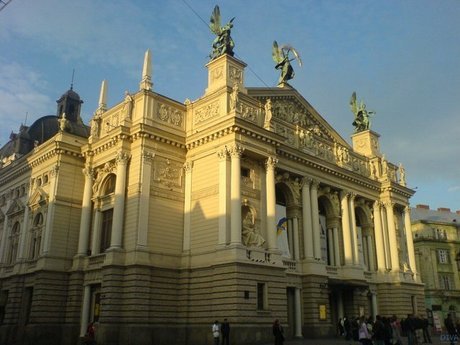Austrian Lviv
Today’s Lviv has become synonymous with Ukrainian nationalism, but in reality 19th century Lviv was in many was the archetypal Habsburg city, populated by a diverse ethnic and national mix of communities that reflected the multi-ethnic make-up of the Habsburg crown’s patchwork domains. This multi-national population turned Lviv in a proud imperial city and created an ambience that remains tangible in the gentle Austrian architecture and thoughtful coffee shop culture of today’s Lviv. The empire conjures up images of cream cake and coffee in a cultured setting, and doesn’t really seem like occupation. It is not uncommon to refer to the Habsburg period as a Golden Age of religious tolerance, booming trade and great construction works. This is not to say that Ukrainians were always at odds with the Habsburgs. When the first university opened in Habsburg Lviv in 1784 instruction was offered in Latin, German and Polish, and it was only three years later that Ukrainians were allowed to create their own Rutherian faculty.
Lviv under the Poles had, by the middle of the eighteen century, come to be a period of stagnation and poverty, perhaps best exemplified by the tale of how the visiting Austrian Emperor Joseph II found himself trapped in a huge pothole outside the city gates when paying a visit in 1783, less than ten years since he’d taken control of the province itself. This personal encounter with the harsh realities of life in post-Polish Lviv may well have focused the Emperor’s mind on the task at hand – certainly the Austrians set about renovating their new position and bringing it up to scratch. Much of Lviv’s distinctive early modern city centre dates from this prolonged burst of Habsburg building throughout the 19th century. Much of the work was selected following open tenders that attracted some of the most talented architects of the era, and this system also helped create the incredible eclectic ensemble on display in central Lviv.
For most Lviv citizens, the Habsburg period is just a name, or perhaps a legend. There is little to suggest that Lviv was a particularly prosperous city in the 19th century, at least by European standards, but because the subsequent eras were such bitter periods in Ukrainian history, the Habsburg Empire has come to be viewed as somehow benign and beneficial. This is partly thanks to the freedoms and sway Ukrainians were eventually able to enjoy under the Habsburg’s federal system, but it is also partly acknowledgement that a very large part of what makes Lviv so special today is thanks to the diligence and excellence of the early modern Habsburg system. In honour of their Habsburg heritage Lviv citizens are expected to renamed a street in the city Viennese Street, and this homage to the Habsburg past looks likely to continue for some time yet.
Building No. 1/3 at the corner of Svobody Prospect and Kopernika Street, known as the Hausner House, and the most beautiful Empire building in Lviv, was built in 1809-1822. In the 1850s Archduke Karl Ludwig of Austria lived here. The building's façade is adorned with numerous reliefs on mythological themes, including compositions of Amor and Psyche and Paris kidnapping Helen by the Lviv sculptor Gartman Witwer.
The Museum of Ethnography and Arts and Crafts in 15 Svobody Avenue was built in 1891 and designed by Julian Zachariewicz for the Halytska Savings Bank. The façade of the grand romantic building is decorated with rusticated stone, polychrome brick, and forged metal. The top of the building is adorned with a dome and the sculptural group of Savings by Leonardo Marconi; its central figure resembles the American Statue of Liberty. It was this Lviv sculpture that in 1884 inspired the creation of the sculpture later given by France to the citizens of New York.
The most impressive building in Kopernika Street (No. 15) is the former Palace of the Counts Potocki. The magnificent and exquisite building is regally situated beyond its decorative iron gate. Designed in 1890 by Lviv architect Julian Cybulski in the style of French Renaissance, this imposing palace is adorned with reliefs, stucco mouldings, wall-paintings, and stained glass.
The Neo-Gothic building No. 11 in Valova Street of 1910 was designed by architect A. Schlehen. The stylized lancet windows are quite interesting. The medieval knights on the second floor balcony hold shields with the heraldic emblems of lands of Western and Eastern Halychyna, Volyn, and the emblem of Lviv.
6 Knyazya Romana Street was built in 1912-1914 of dark masonry in the spirit of German Jugendstil. It instantly invites attention by its unusual stylization of the Middle Ages. The figures of sullen knights-atlases and the bas-reliefs of ferocious lions convey a mood of a severe ancient epoch, although at the same time the building displays features of refinement particular to early 20th century Secession architecture.
The unique mixture of nationalities in Lviv can be sensed even today. The city is far from the big-crowded tourist destinations like Prague or Krakow, so it offers a different type of experience. You can visit the city directly via flights to Lviv International Airport or to Kiev.




